- off.road.cc
- Dealclincher
- Fantasy Cycling

Support road.cc
Like this site? Help us to make it better.
- Sportive and endurance bikes
- Gravel and adventure bikes
- Urban and hybrid bikes
- Touring bikes
- Cyclocross bikes
- Electric bikes
- Folding bikes
- Fixed & singlespeed bikes
- Children's bikes
- Time trial bikes
- Accessories - misc
- Computer mounts
- Bike bags & cases
- Bottle cages
- Child seats
- Lights - front
- Lights - rear
- Lights - sets
- Pumps & CO2 inflators
- Puncture kits
- Reflectives
- Smart watches
- Stands and racks
- Arm & leg warmers
- Base layers
- Gloves - full finger
- Gloves - mitts
- Jerseys - casual
- Jerseys - long sleeve
- Jerseys - short sleeve
- Shorts & 3/4s
- Tights & longs
- Bar tape & grips
- Bottom brackets
- Brake & gear cables
- Brake & STI levers
- Brake pads & spares
- Cassettes & freewheels
- Chainsets & chainrings
- Derailleurs - front
- Derailleurs - rear
- Gear levers & shifters
- Handlebars & extensions
- Inner tubes
- Quick releases & skewers
- Energy & recovery bars
- Energy & recovery drinks
- Energy & recovery gels
- Heart rate monitors
- Hydration products
- Hydration systems
- Indoor trainers
- Power measurement
- Skincare & embrocation
- Training - misc
- Cleaning products
- Lubrication
- Tools - multitools
- Tools - Portable
- Tools - workshop
- Books, Maps & DVDs
- Camping and outdoor equipment
- Gifts & misc
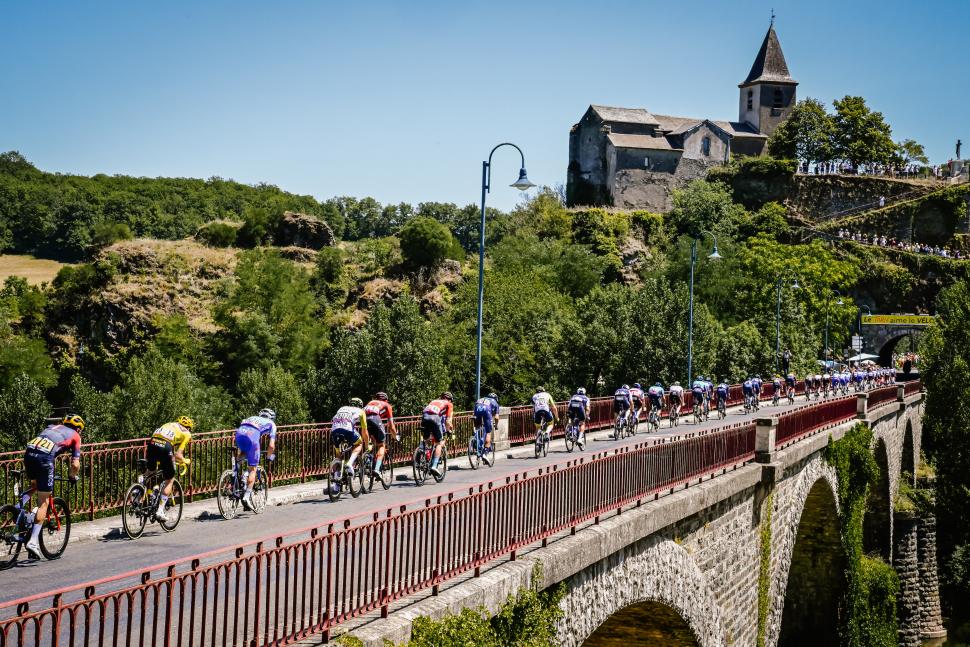
The unwritten rules of the Tour de France - what are they and how are they enforced?
First Published Jul 11, 2022
20 years ago this July, on the final climb of the final mountain stage of the 2003 Tour de France, Jan Ullrich finally looked capable of defeating his old adversary, Lance Armstrong. For arguably the only time during his seven-year-reign, the disgraced Texan appeared out-of-sorts at the Tour. Throughout the Pyrenees, with a rejuvenated Ullrich – the winner of the 1997 Tour and by this point already twice a runner-up to the American – breathing down his neck, Armstrong and his manager Johan Bruyneel’s tactics were simple: “hang on”.
And then, on that final showdown on Luz Ardiden, the yellow jersey hit the deck. Hugging a slight right-hand bend, Armstrong’s handlebars tangled with a child’s bag, sending him to the ground with a thud.
As Armstrong struggled with his pedals (and almost headbutted his handlebars) during a frantic effort to regain contact, Ullrich called a halt to hostilities in the lead group.
In his 2022 biography of Ullrich, Daniel Friebe writes that the German hero felt bound by “an unwritten cycling diktat – that, when a rival crashes or punctures, you wait, particularly if he’s in the yellow jersey.”
For Ullrich, so close to a redemptive second Tour win, the choice was simple because, as he put it after the stage, “fairness is everything in sport”. And besides, Armstrong had done the same for him after a similar incident two years before.
Following Ullrich’s adherence to cycling’s unwritten code (a gesture somewhat indicative of the honour amongst thieves which existed in the peloton during that murky era), the US Postal rider – adrenaline coursing through his veins – attacked and won the stage, and with it the Tour. Ullrich was devastated.
Seven years later, Andy Schleck was in yellow on the Port de Balès during the penultimate Pyrenean stage of the race. Schleck – the Ullrich to Alberto Contador’s Armstrong – stood on the pedals to attack. As he changed gear, he dropped his chain. Contador, who had accelerated to match Schleck’s burst, simply kept going, as his closest rival forlornly fumbled with his bike at the side of the road. Social media outrage and questionably sincere video apology aside, chaingate – as it quickly became known – effectively won Contador the Tour.
These two incidents, so similar in nature but with strikingly different outcomes, highlight that while there's a whole book of regulations that govern the Tour de France, an age-old set of unwritten rules also determine how the race develops.
We’ll forgive you for being confused by these. As we saw in the Pyrenees in 2003 and 2010, they are incredibly open to interpretation and often create more problems than they solve, but we thought that we’d take a look at some that you might find mentioned during this year’s Tour de France.
First, and most confusing of all…
You can’t attack the maillot jaune when the following happens…
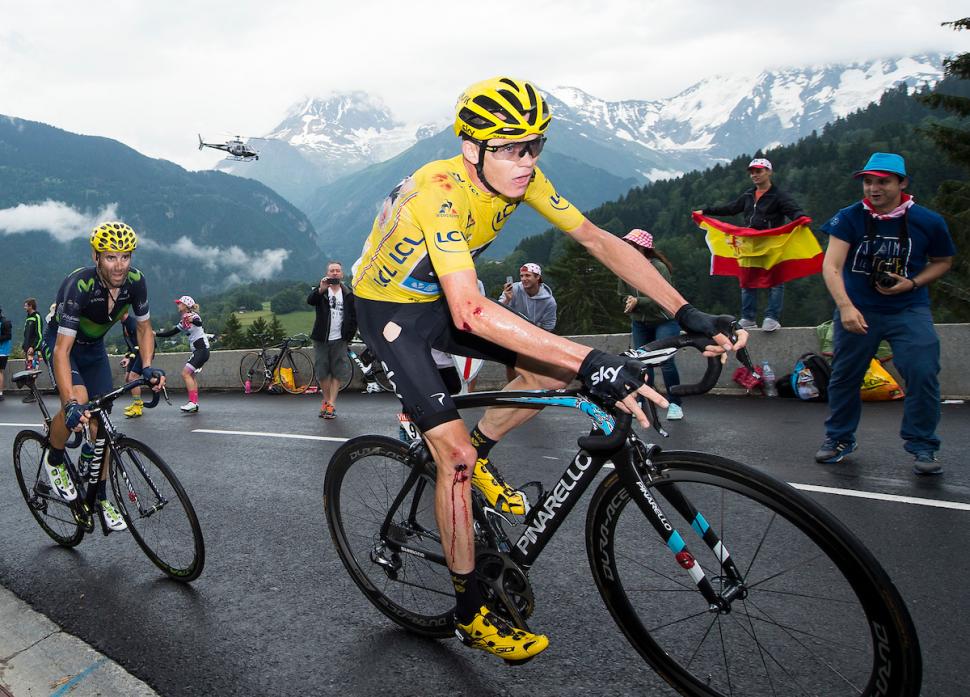
They crash: If the leader of the race goes down in a crash then don’t you be thinking about attacking until they are safely back in the bunch. But that’s only if the racing hasn’t really kicked off yet, of course.
If the peloton is lined out with riders fighting to stay in contact, then it’s fair game (sometimes). Even during the heat of battle, a truce can be achieved if those at the front believe that a rival has been hampered by circumstances beyond their control.
How does this get decided? As we saw in 2003 with Ullrich, who stood the most to gain from Armstrong’s misfortune, the riders at the front usually decide, following a lot of conversation and hand waving.
They suffer a mechanical problem: Like a crash, this one is subject to the race situation at the time of the incident. If the racing is on, with the pace high and attacks already flying off the front, then the yellow jersey just has to get on with it and get back to the front of the race.
In fact, mechanicals are considered by many to be simple bad luck. Contador attacking Schleck in what became known as ‘chaingate’ is the perfect example of this. One side of the argument (and believe me, this went on for weeks back in 2010) says that Contador showed the ruthless instinct of a winner while others reckoned that it was bad form to take advantage of Schleck's chain coming off. You just shouldn’t have dropped that chain, Andy!
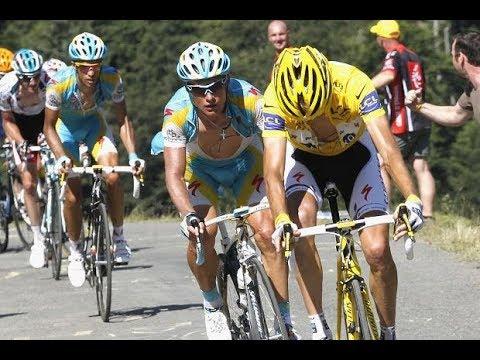
But (just to confuse matters further) when Chris Froome shipped his chain in 2017, Fabio Aru – who had hit the front just as the Team Sky rider glanced down at his misfiring bike – was chastised by his rivals, who ordered the Italian champion to call off his attack until Froome had regained his place in the group.
The bottom line? Normally, the riders adhere to the unwritten rule that a Tour de France should not simply be won by luck or through another rider’s misfortune…
Unless, of course, your rivals want to gang up on you to force you out of yellow; a fate suffered by French hope Jean-François Bernard at the 1987 Tour, who shipped a chain and then punctured just as Stephen Roche, Pedro Delgado and a few others took flight on the way to Villard-de-Lans. He never saw them, or yellow, again.
I told you it was complicated…
They stop for a nature break: This one, thankfully, is a bit more straightforward (mostly). If the start of a stage has been fast and a small group has gained a small advantage over the peloton, the yellow jersey stopping for a piddle is the sign that the peloton will now relax and let the breakaway take a few minutes' lead.
A collective sigh of relief will be released around the peloton when the yellow jersey's hand goes up. Riders of a team that has failed to make the breakaway may now quietly remove their radio earpieces as the team manager won’t be best pleased.
Of course, while this particular unwritten rule tends to be followed religiously, sometimes a poorly timed nature break (and some opportunistic tactical manoeuvring on the part of rivals) can prove fatal to a race leader.
Just ask Demi Vollering, who stopped for a pee alongside her SD Worx teammates on stage six of this year’s Vuelta Femenina, only for Annemiek van Vleuten’s Movistar team – instigating a pre-planned tactic, they later claimed – to begin drilling it on the front.
That conveniently timed attack proved enough, just, for Van Vleuten to take the overall win, despite her younger compatriot looking stronger throughout the week, and prompted Vollering to accuse the world champion of breaking one of cycling’s most sacred unwritten rules. The SD Worx leader may have been furious, but Van Vleuten was the winner. And, at the end of the race, that’s all that matters.
Drafting is ok(ish)

Coming back from a crash, mechanical or nature break will require a racer to ride at a speed faster than the peloton. That’s difficult, so the rider will take a draft in the convoy of team cars to make things easier. This is actually not allowed, but the race jury generally turns a blind eye as otherwise they’d have half of the peloton disqualified for being outside of the time limit every day.

But sometimes the race jury notices, and then drafting a car is suddenly not ok. This is usually when the racing is at a critical stage, or if a rider is taking an unfair amount of time behind their team car. Sounds woolly at best? It is.
Poor old Nils Eekhoff was disqualified from the U23 World Championships after he had crossed the line first. The jury decided that his drafting of a car with 125km left to race – after he had crashed and waited to be examined by the race doctor – constituted a breach of the rules.
The whole situation made many question the jury’s decision, though others were simply frustrated by the lack of consistency around the enforcement of this rule.
Speaking of a lack of consistency…
During the second stage of last year’s Tour, when the race was still in Denmark, a ‘barrage’ was called by the commissaires (ordering team cars out of the gap between the peloton and a chasing group, so the chasers can’t take advantage of the cars’ draft) as Rigoberto Uran attempted to regain contact following a crash on a bridge, but not when race leader Yves Lampaert went down. Murky indeed.
You scratch my back…
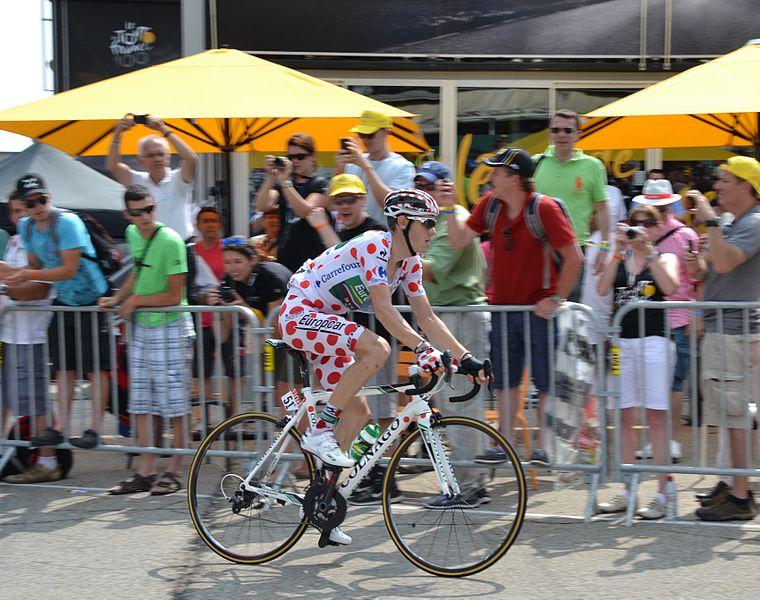
If you’ve ever looked at a bike race and wondered why certain riders are working in the breakaway and others aren't, the answer is often that they're trying to achieve different things.
One rider might be chasing the mountain points on offer at the top of climbs, while another needs the points from the intermediate sprint. These riders won’t contest the other rider’s competition, though all are expected to shoulder an equal workload in the effort to keep the breakaway ahead of the peloton.
Once a rider has collected all of their points available for that day, they may well give their breakaway companions some extra help on the front of the bunch, especially if those riders have allowed them to take points uncontested.
This unwritten rule is highly nuanced and full of sub-plots and mini rivalries.
The peloton will decide when to race
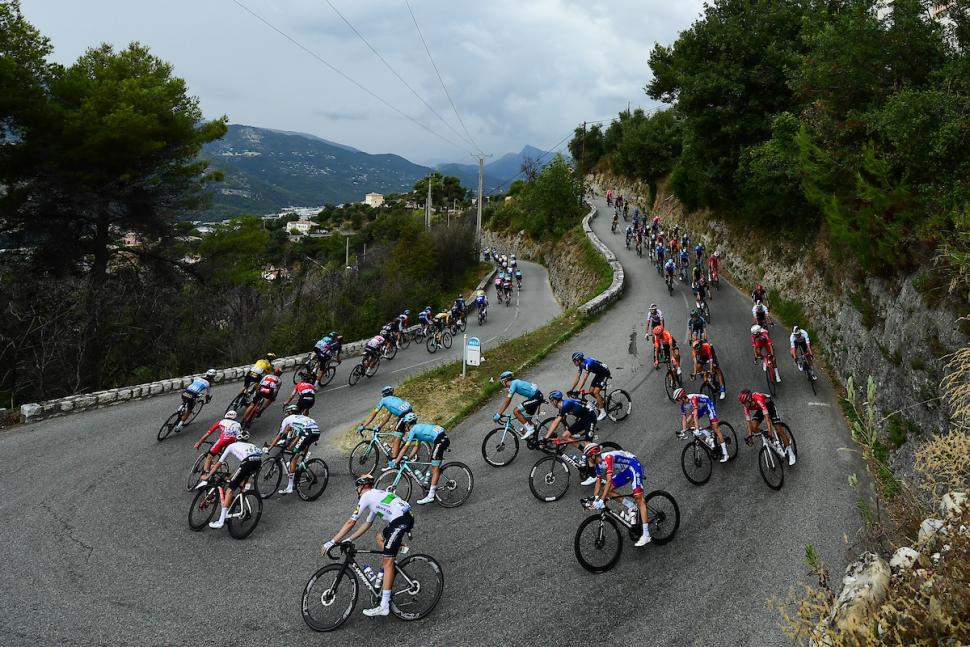
The peloton has in the past decided to neutralise the race if they feel that it is too dangerous. This can be because of poor road conditions, extreme weather or because of too many crashes. We've also seen protests to highlight danger in races, such as the mini stoppage that happened at the beginning of stage four in 2021 following a number of terrible crashes in the preceding days.
Stage one of the 2020 Tour saw a downpour on roads that hadn’t seen rain in several weeks. The result was a number of crashes, and the decision was taken to neutralise a descent to the finish before the race started again on the flat run to the line.
In situations like this, the peloton will turn to its 'patrons'. In years gone by, this would have been one dominant rider – Merckx, Hinault, Cancellara – but today there isn’t one voice that controls proceedings. Instead, senior riders and road captains like Luke Rowe would collectively agree to take that decision, and the peloton follows their lead.
When Astana’s Omar Fraile decided to ignore this and push the pace on the descent, he received quite a bit of abuse as he was absorbed by the peloton.
The final stage is a procession... until it isn't
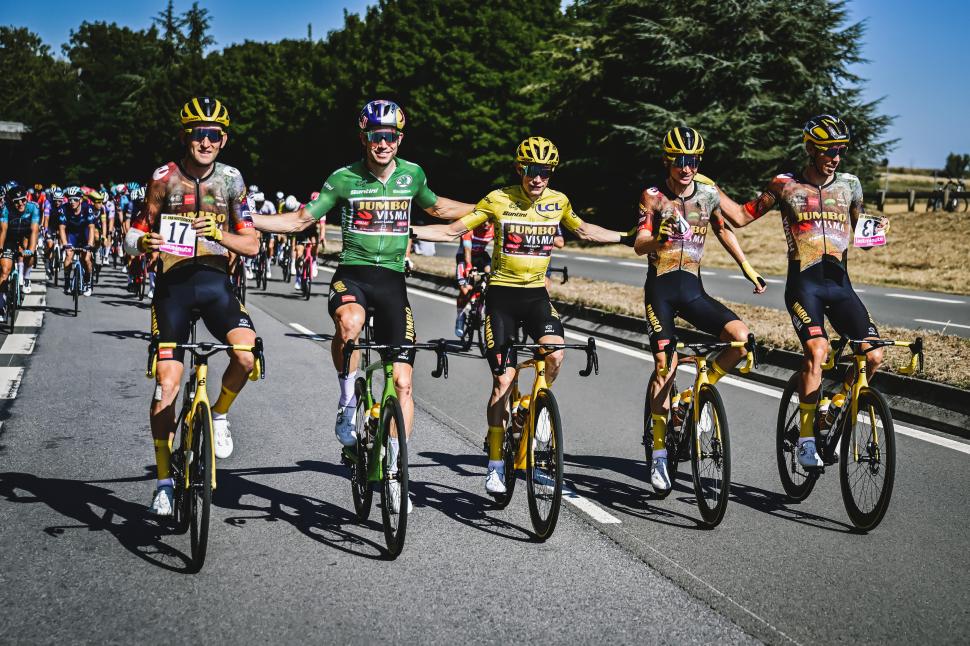
There is absolutely no written rule that states that the final stage of the Tour de France should have no outcome on the overall race, but this is the way it has been for years. The final day is reserved for sipping champagne, taking team pictures, and generally rolling along at a speed that makes half the peloton nervous about missing their flight home.
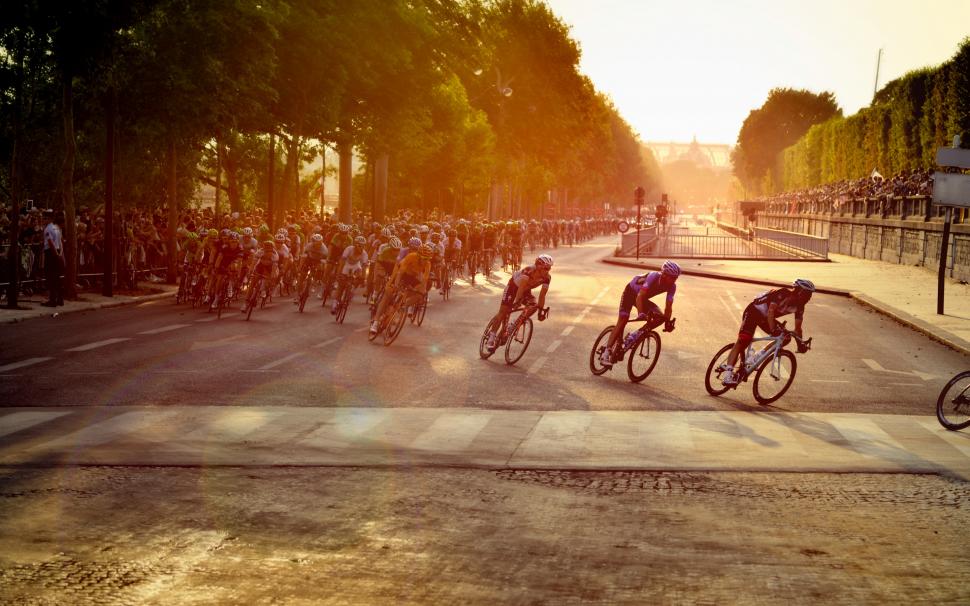
Generally, the race starts just outside of Paris and rolls at this leisurely speed until the riders hit the Champs Elysees (or when the Eiffel Tower comes into view, as tradition dictates). The team of the yellow jersey usually leads the race across the finish line on the first lap, though a rider that is retiring may be allowed to roll off the front for the honour.
After that, the eight laps up and down the famous boulevard are suddenly a proper race again with attacks that are almost certain to fail, heading up the road before the sprint is won and the race is finished.
However, with the 2024 Tour de France set to finish in Nice to avoid a clash with the Paris Olympics , we may finally be treated to some ‘proper racing’ - with maybe even the yellow jersey up for grabs - on the final day for the first time since 1989… We can hope anyway!
A benevolent yellow jersey
It may seem hard to believe now, in an era when Tadej Pogačar and Jonas Vingegaard appear intent on gobbling up everything before them at the Tour, but there was a time when the dominant rider at the Tour de France was expected to share the love around the peloton, and dole out favours and stage wins like a yellow-clad Father Christmas.
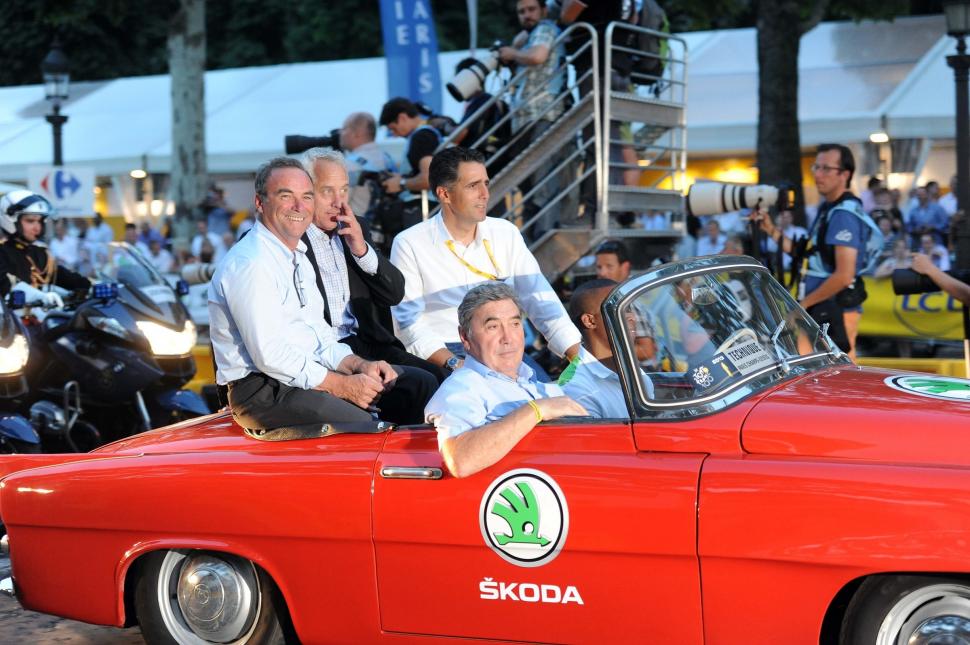
That tradition arguably began in the early 1990s, when Big Miguel Induráin eschewed the cannibal-like instincts of Merckx and the iron-fisted bravado of Hinault for a more genteel form of domination, bartering stage wins and fleeting glimpses of glory to his fellow riders for an easier passage through five straight Tour victories. He was going to win anyway, so why be greedy?
Even Lance “No Gifts” Armstrong carried on that tradition for the most part, letting the likes of Ivan Basso, Alejandro Valverde, and Marco Pantani cross the line ahead of him (though he quickly came to regret letting Il Pirata beat him to the top of the Ventoux in 2000).
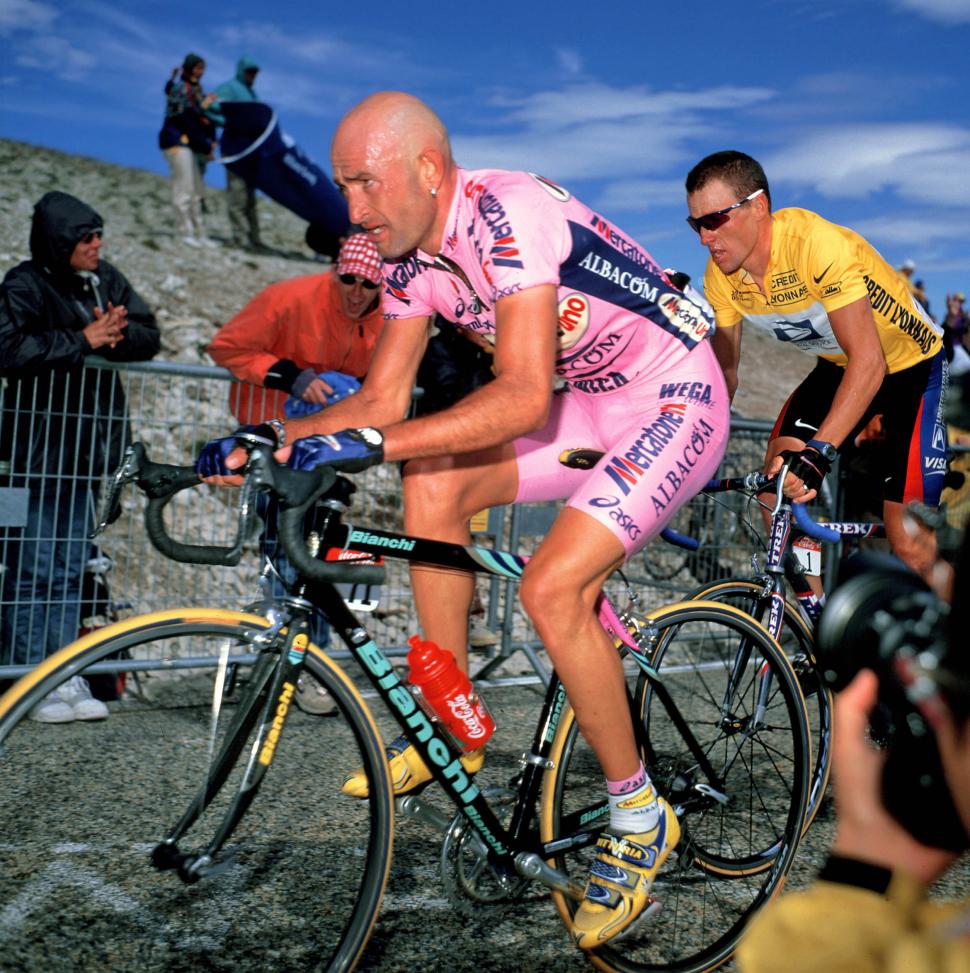
Vingegaard, meanwhile, notably eased up during last year's final time trial to gift the win to teammate Wout van Aert, though doesn't seem as yet minded to dole out favours to rivals. Pogačar, for his part, appears to have no need or desire to curry favour with the peloton either. Perhaps they’ll both mellow in their old age?
Café wisdom: road.cc readers on unwritten rules of the Tour de France
In a previous edition of this feature, kil0ran added to our list of unwritten rules with these unconventional traditions:
"If you pick up a jersey due to a penalty you must make clear that it's not how you'd like to have won it.
"See also the rare occurrence of the maillot jaune (or any maillot) being unable to start the next day due to injury. Or disqualification."
kil0ran's point about a race leader abandoning while in the leader's jersey was even raised at this year's Giro d'Italia.
Cycling tradition dictates that if a rider finishes a stage in the overall lead but fails to start the next day, no-one should wear the yellow jersey on that stage – as it has yet to be earned by anyone other than the unfortunate DNSer (once that stage finishes, it’s good to go of course).
At the Giro, however, Geraint Thomas rocked up after the rest day in the pink jersey, despite race leader Remco Evenepoel only pulling out with Covid following the stage nine time trial.
I suppose jersey sponsors have paid their money for a reason…
Clear as mud, isn't it? If you have any more unwritten rules to add, let us know in the comments!
Main image: ASO, Pauline Ballet
Help us to fund our site
We’ve noticed you’re using an ad blocker. If you like road.cc, but you don’t like ads, please consider subscribing to the site to support us directly. As a subscriber you can read road.cc ad-free, from as little as £1.99.
If you don’t want to subscribe, please turn your ad blocker off. The revenue from adverts helps to fund our site.
Help us to bring you the best cycling content
If you’ve enjoyed this article, then please consider subscribing to road.cc from as little as £1.99. Our mission is to bring you all the news that’s relevant to you as a cyclist, independent reviews, impartial buying advice and more. Your subscription will help us to do more.
Ryan joined road.cc in December 2021 and since then has kept the site’s readers and listeners informed and enthralled (well at least occasionally) on news, the live blog, and the road.cc Podcast. After boarding a wrong bus at the world championships and ruining a good pair of jeans at the cyclocross, he now serves as road.cc’s senior news writer. Before his foray into cycling journalism, he wallowed in the equally pitiless world of academia, where he wrote a book about Victorian politics and droned on about cycling and bikes to classes of bored students (while taking every chance he could get to talk about cycling in print or on the radio). He can be found riding his bike very slowly around the narrow, scenic country lanes of Co. Down.
Add new comment
Latest comments.
Again objective vs subjective safety:...
Make it one way - uphill only for bikes, 2 way for pedestrians. Cyclists on the left, walkers on the right. Nobody on a bike is going to be going...
I once saw a blind dog being walked down the steps of the horseshoe bridge, where the Kennet meets the Thames, or the NCN 5 starts from the 4, it...
I have just acquired my first ever set of handbuilt wheels via my LBS - 28 spoke Open Pro C with Miche Primato QR hubs, the wheelbuilder's own...
Warning after objects to puncture tyres found in Droitwich...
No, it should not go back to being a two-way street, at least not in the way JRM means. In fact it would be better if it went to being buses and...
No that doesn't show you didn't edit your original post, it just shows you think you are smarter than you actually are and doing another...
car crashes into building deliberately...
Looks like they're doing a bit of repainting of it tonight: https://www.bristolpost.co.uk/news/local-news/optical-illusion-cycle-lane-caused-9219854
“I’m hoping the timings will be such that cyclists don’t have long to wait. I understand that the Essex designers have received training from...
- Spring Classics
The Tour De France: 8 Unwritten Rules, Obscure Regulations & Weird Facts!
- Share on Facebook
- Share on Twitter
The Tour de France, the most fantastic race on earth. For the month of July, cycling fans are glued to the action. In this video, we will list a few of the weirder facts you may not know about The Tour de France. We've also enlisted the help of GCN+’s own Cillian Kelly to dive into some of the lesser-known historical facts of this crazy race.
0:00 - Intro 1:12 - Podium dress code 1:36 - Keeping cool 2:11 - Unwritten rules 3:19 - Historical facts 7:23 - Team cars 8:18 - The party stage 9:07 - Time cut 10:07 - Time gaps
Useful Links: GCN+ | Every. Unmissable. Moment. 👉 https://gcn.eu/9jv Download the GCN App for free 👉 https://gcn.eu/app Visit the GCN Shop 👉 https://gcn.eu/french-casuals Join the GCN Club 👉 https://gcnclub.com GCN Training Plans 👉 https://gcn.eu/gcntp
Are you tuning in to the Tour de France? 🚴 Let us know in the comment section below! 💬
Watch more on GCN... 📹 Tadej Pogačar’s Tour De France Training Secrets 👉 https://youtu.be/Hyx49FCjQmY 📹 Watch our Editor’s Choice Playlist 👉 https://gcn.eu/editorschoice 📹 Or why not check out our Features Playlist 👉 https://gcn.eu/gcnfeatures
🎵 Music - licensed by Epidemic Sound 🎵 Whip Whoosh 4 - SFX Producer Accessing the Stratosphere - Christian Andersen Bulking Season - Timothy Infinite Dowel Swishes 11 - SFX Producer Get in Here - Smartface Grand Theft (Instrumental Version) - Katori Walker Prisma - Ben Elson Smokeshow - Jobii Soft Glare - Mar Vei Solid Centre - Dusty Decks Speaker Pop Home 1 - SFX Producer Speaker Pop Home 2 - SFX Producer Too Humid - Dylan Sitts Vice City - Ben Elson
#gcn #cycling #roadcycling #roadbike #bike #bikes #bikelife #tourdefrance #tdf2023 #tourdefrance2023
📸 Photos - © Velo Collection (TDW) / Getty Images & © Sprint Cycling Agency
The Global Cycling Network (GCN) is the largest online cycling channel in the world, bringing together a global community of road cyclists to celebrate everything that’s great about the world of cycling.
Our videos bring fans compelling daily content including expert tutorials, techniques, training, racing, cutting-edge bike tech, unparalleled behind the scenes event coverage, humour, entertainment, and more.
Presented by ex-pro riders, GCN offers a uniquely qualified insight into the world of cycling, and most importantly it’s fuelled by our passionate and enthusiastic fans – everyone who makes up the GCN community. We also bring the latest and greatest tech to your attention, showcase the best places in the world to ride and get exclusive access to events and races.
Welcome to the Global Cycling Network | Inside Cycling
Thanks to our sponsors: Pinarello Bikes: https://gcn.eu/Pinarello Zipp Wheels: https://gcn.eu/Zipp Topeak Tools: http://gcn.eu/Topeak Canyon Bikes: http://gcn.eu/-Canyon Pirelli Tyres: https://gcn.eu/Pirelli Orbea Bikes: http://gcn.eu/Orbea Vision Wheels: http://gcn.eu/Vision Wahoo Fitness: http://gcn.eu/Wahoo-Fitness Park Tool: http://gcn.eu/-parktool Elite Bottles: https://gcn.eu/EliteBottles Whoop Fitness: https://gcn.eu/Whoop Selle Italia: https://gcn.eu/SelleItalia SIS: https://gcn.eu/ScienceInSport Zwift: https://gcn.eu/Zwift Shimano Wheels: https://gcn.eu/Shimano Shadow Stand: https://gcn.eu/ShadowStand DMT Shoes: https://gcn.eu/DMT Silca: https://gcn.eu/Silca MET Helmets: https://gcn.eu/methelmets Strava: https://gcn.eu/strava
Watch our sister channels: GCN Tech - https://www.youtube.com/@gcntech GCN Racing - https://www.youtube.com/@gcnracing Global Triathlon Network - https://www.youtube.com/@gtn GCN Italia - https://www.youtube.com/@gcnitalia GCN en Español - https://www.youtube.com/@gcnenespanol GCN auf Deutsch - https://www.youtube.com/@gcnaufdeutsch GCN en Français - https://www.youtube.com/@gcnenfrancais GCN Japan - https://www.youtube.com/@gcnjapan GCN Training - https://www.youtube.com/@gcntraining Global Mountain Bike Network - https://youtube.com/@gmbn GMBN Racing - https://youtube.com/@gmbnracing GMBN Tech - https://www.youtube.com/@gmbntech Electric Mountain Bike Network - https://www.youtube.com/@embn
Latest Videos
1 Is Tech Making Racing Too Dangerous? | Tech Show 329

2 Be More Aero On A Budget With These Top Tips!

3 How To Ride Steep Climbs

4 Di2 Downgrades, Old Shifters & Clean Bike Helmets | GCN Tech Clinic

5 Why So Many HUGE Crashes Right Now? | GCN Show Ep. 587

More GCN videos

Be More Aero On A Budget With These Top Tips!
How can you get more aero on the bike and save those key watts, without breaking the bank? Hank and Manon are here with their top tips to become more aero on the bike without spending a fortune.

How To Ride Steep Climbs
Many of us cyclists hate steep climbs! But you can learn to enjoy, and perhaps even master every mountain, pass, or brutal short climb you tackle with these top tips for pacing, technique and mindset.

Why So Many HUGE Crashes Right Now? | GCN Show Ep. 587
Why are there so many crashes in pro cycling at the moment?

I Tried To Finish The Tour Of Flanders With Just 8 Weeks Of Training
I Tried To Finish The Tour Of Flanders With Just 8 Weeks Of Training After 8 challenging weeks of training aided by Wahoo SYSTM, Cillian is gearing up to take on the Tour of Flanders, known as one of the most challenging sportives in the world. Is he prepared for its cobbled paths, daunting climbs, and the 160 kilometres of road that lie ahead at the Ronde van Vlaanderen? Will he manage to make it across the finish line?
Subscribe to the GCN Newsletter
Get the latest, most entertaining and best informed news, reviews, challenges, insights, analysis, competitions and offers - straight to your inbox
14 Tour de France rules you probably didn't know
The world's biggest bike race has a comprehensive set of rules - here are some regulations that may not be commonly known
- Sign up to our newsletter Newsletter

The Tour de France is cycling’s most prestigious race, but even so there are probably some rules and regulations governing the running of the event and the conduct of the riders, teams and staff which you probably haven’t heard of.
From glass containers to race numbers, here are a selection of rules you may not know:
1. Glass containers
Under article 6b of the regulations, carrying using glass containers is strictly prohibited.
2. Waterproofs
Article 5 states that the wearing of leader waterproofs other than those provided by the race organisers is forbidden.
3. TVs in team cars
Get The Leadout Newsletter
The latest race content, interviews, features, reviews and expert buying guides, direct to your inbox!
Teams have to ensure no accredited vehicle belonging to them has a television in front of their vehicle, under article 9.
Competitors who commit assault, utter insults, threaten or wilfully cause delays or demonstrations will be penalised - Article 9.
5. Level crossings
If a group of riders gets split into two as the result of a level crossing closing, the first part of the group will be slowed down or stopped to allow the riders that have been delayed to regain their place in said group - Article 19.

6. Glasses at official proceedings
Official proceedings at the start and finish of races dictates that, out of respect for the public, the wearing of glasses (and sunglasses) - other than prescription ones - simply isn’t allowed.
In the event of a tie in the general ranking, the number of stage victories are added up for each rider, followed by the number of intermediate sprint victories; if there is still no clear winner, the individual time ranking is used - Article 24.
8. Race numbers
Article 2 states it is strictly forbidden to make changes to official items, such as bibs or numbers plates.
9. Spraying from team car
Any spraying of competitors from a team vehicle is strictly forbidden - Article 6b.
10. Indecent appearance
Under article 28.2, ASO may exclude from the event any team or any of its members in the event of customs fraud or indecent appearance.
11. Gambling
In order to avoid any risk of a conflict of interest, the teams and each of their members (riders, supervisory staff, trainers, doctors, etc.) are obliged not to personally take part in sports betting ventures concerning the Tour de France, either directly or through an intermediary - Article 30.
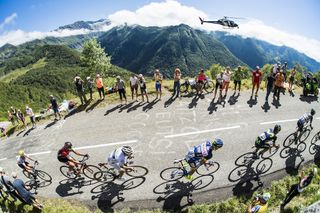
12. Retirement
Any notably unjustified retirement may lead to the withdrawal of all prizes won since the start of the race - Article 8.
13. Refusing to take part in official proceedings
Under article 21, any prize-winner who refuses to take part in the official proceedings at the start and the finish in his race outfit will be penalised.
14. Splits in the bunch
All riders in a given bunch shall be credited with the same time when they cross the finishing line. A split occurs when the gap of over 1 second is noted between two riders. Timekeeper–commissaires shall give a new time. However, in stages expected to finish in bunch sprints, the time gap required for a split shall be 3 seconds - Article 14.
Thank you for reading 20 articles this month* Join now for unlimited access
Enjoy your first month for just £1 / $1 / €1
*Read 5 free articles per month without a subscription
Join now for unlimited access
Try first month for just £1 / $1 / €1
Founded in 1891, Cycling Weekly and its team of expert journalists brings cyclists in-depth reviews, extensive coverage of both professional and domestic racing, as well as fitness advice and 'brew a cuppa and put your feet up' features. Cycling Weekly serves its audience across a range of platforms, from good old-fashioned print to online journalism, and video.

Riding on cobbles is fun - you should try and find the pavé in your town and go on a silly ride with a club
By Adam Becket Published 10 April 24

Coach, wind-tunnel technician and former full-time athlete Andy Turner lifts the lid on performance gains on minimal hours
By Andy Turner Published 10 April 24
Useful links
- Tour de France
- Giro d'Italia
- Vuelta a España
Buyer's Guides
- Best road bikes
- Best gravel bikes
- Best smart turbo trainers
- Best cycling computers
- Editor's Choice
- Bike Reviews
- Component Reviews
- Clothing Reviews
- Contact Future's experts
- Terms and conditions
- Privacy policy
- Cookies policy
- Advertise with us
Cycling Weekly is part of Future plc, an international media group and leading digital publisher. Visit our corporate site . © Future Publishing Limited Quay House, The Ambury, Bath BA1 1UA. All rights reserved. England and Wales company registration number 2008885.
Site search
- Secret Base
- DraftKings Sportsbook
- DraftKings Daily Fantasy Sports
- DraftKings Network
- Fantasy Football
- Arizona Cardinals
- Atlanta Falcons
- Baltimore Ravens
- Buffalo Bills
- Carolina Panthers
- Chicago Bears
- Cincinnati Bengals
- Cleveland Browns
- Dallas Cowboys
- Denver Broncos
- Detroit Lions
- Green Bay Packers
- Houston Texans
- Indianapolis Colts
- Jacksonville Jaguars
- Kansas City Chiefs
- Las Vegas Raiders
- Los Angeles Rams
- Miami Dolphins
- Minnesota Vikings
- New England Patriots
- New Orleans Saints
- New York Giants
- New York Jets
- Philadelphia Eagles
- Pittsburgh Steelers
- Los Angeles Chargers
- San Francisco 49ers
- Seattle Seahawks
- Tampa Bay Buccaneers
- Tennessee Titans
- Washington Commanders
- Atlanta Hawks
- Boston Celtics
- Brooklyn Nets
- Cleveland Cavaliers
- Dallas Mavericks
- Detroit Pistons
- Golden State Warriors
- Houston Rockets
- Los Angeles Lakers
- Milwaukee Bucks
- Minnesota Timberwolves
- New York Knicks
- Philadelphia 76ers
- Phoenix Suns
- Portland Trail Blazers
- San Antonio Spurs
- Sonics Rising
- Toronto Raptors
- Washington Wizards
- G-League and International
- Bracketology
- Women’s CBB
- Cinderella Stories
- View team list
- Swish Appeal
- Los Angeles Sparks
- Minnesota Lynx
- New York Liberty
- Washington Mystics
- Arizona Diamondbacks
- Atlanta Braves
- Baltimore Orioles
- Boston Red Sox
- Chicago Cubs
- Chicago White Sox
- Cincinnati Reds
- Cleveland Guardians
- Colorado Rockies
- Detroit Tigers
- Houston Astros
- Kansas City Royals
- Los Angeles Angels
- Los Angeles Dodgers
- Miami Marlins
- Milwaukee Brewers
- Minnesota Twins
- New York Mets
- New York Yankees
- Oakland Athletics
- Philadelphia Phillies
- Pittsburgh Pirates
- San Diego Padres
- San Francisco Giants
- Seattle Mariners
- St. Louis Cardinals
- Tampa Bay Rays
- Texas Rangers
- Toronto Blue Jays
- Washington Nationals
- MLB Trade Rumors
- Sabermetrics
- English Premier League
- Aston Villa
- Manchester City
- Tottenham Hotspur
- Leicester City
- Southampton
- Manchester United
- Leeds United
- German Bundesliga
- Bayern Munich
- Italian Serie A
- Inter Milan
- Spanish La Liga
- Atletico Madrid
- Real Madrid
- Women’s Soccer
- Mexican Soccer
- U.S. Soccer
- Fantasy Soccer
- MMA Fighting
- MMA Fighters
- MMA Fight Schedule
Filed under:
- Tour de France
The history and unwritten rules of crashing at the Tour de France
Cycling’s biggest race has a long history of crashes. Here is a guide to the unwritten rules of the Tour de France’s most harrowing moments.
Share this story
- Share this on Facebook
- Share this on Twitter
- Share this on Reddit
- Share All sharing options
Share All sharing options for: The history and unwritten rules of crashing at the Tour de France
/cdn.vox-cdn.com/uploads/chorus_image/image/60288911/452027696.jpg.0.jpg)
Crashes are the worst thing about cycling, especially at the Tour de France . They’re violent and disruptive, and they hurt riders who trained all year to be at the Tour only to go home in bandages. They rob us of fun and rob teams of million-dollar investments.
Crashes have already affected the 2018 Tour de France.Four-time winner Chris Froome lost 51 seconds because he went over a canvas barrier into a ditch . So did Adam Yates and Richie Porte. American Lawson Craddock has been toughing out the first week despite a broken scapula . Richie Porte was forced to abandon on the cobblestones of Stage 9, seemingly cracking his collarbone on a fall and being reduced to tears .
And yet we can’t get rid of crashes. They are as much a part of the sport as the pneumatic tire. They even have their own set of rules, written and unwritten, which often cause cycling’s deeply analytical fanbase to lose its minds for days on end.
Here, then, is your Tour de France crash primer: what they are about, and how they happen, so when that instant comes (and it always comes) you will know what you’re looking at.
To start with, let’s stipulate that nearly all crashes happen for two basic reasons: 1) Two bikes can’t be in the same place at the same time, and 2) Cyclists are fundamentally insane.
:no_upscale()/cdn.vox-cdn.com/uploads/chorus_asset/file/11651583/GettyImages_576502060.jpg)
There are many types of cycling crashes
Crashes start with a rider losing his balance. Sometimes guys bump shoulders and someone goes down. Sometimes riders go down without the help of their competitors, hitting something in the road, overcooking a corner, or slipping on a wet spot (painted surfaces are not your friend on a rainy day).
But the big bunch crashes usually start with a touch of wheels. If you’re packed tightly going 40 miles per hour, trouble could come from any direction. Maybe the guy in front of you taps his brakes at the wrong time, or maybe you aren’t paying attention when the peloton slows down, and your furiously spinning rubber tire rubs up with someone else’s tire spinning the other way.
Usually you’re the one going down in this scenario — front wheels jerk sideways much more easily than rear wheels — and the people around you fall like bowling pins. Fortunes are lost (and, by process of elimination, won) in these moments; in the Tour de France one of those bowling pins could be the favorite to win, and if his helmet or collarbone isn’t up to the impact, a year’s worth of blood, sweat, and tears will have meant nothing.
Bunch crashes on the flats are bad enough, but usually the victims are able to get up and go on. The horror crashes typically happen on descents , where riders have even died from hitting the deck at high speed. Sometimes those bad impacts are due to bad luck. Heads have limits to what they can sustain, even inside a helmet.
Those are the crashes that leave a mark on the soul of the sport. Obviously the fate of the rider and his loved ones are the real story, but we fans have scars on our souls, too, that ache every time we hear names like Weylandt and Casartelli and Goolaerts.
But nobody wants to talk about those. The crashes we talk about the most happen in sprints . We accept them as part of the sport, even joke about them sometimes because, amazingly, riders tend to emerge intact, or close to it.
Google “Haselbacher” and “crash” and you will be treated to articles about an Austrian sprinter known for the occasional cartwheel in the final meters of sprints. (Rene Haselbacher is his name, and he’d like you to forget that he was known for crashing too much, thank you.) We got some mileage out of a crash in Turkey a few years back where it looked like Dutch sprinter Theo Bos had pulled a nifty little sumo maneuver in taking out Daryl Impey as the pair dueled down the stretch.
:no_upscale()/cdn.vox-cdn.com/uploads/chorus_asset/file/11651669/GettyImages_161742391.jpg)
Cycling crashes are governed by a ton of unwritten rules
When we debate who did what to whom is when things get … complicated. Sprint crashes are 99 percent the fault of someone moving sideways, in direct violation of the written rule that you have to hold your line in the sprint.
Nobody cares about written rules. I reiterate what I wrote above: cyclists, and especially sprinters, are fundamentally off their rockers, and will try to fit themselves into spaces where they don’t belong any way they can. At 45 miles per hour.
Everybody takes cycling’s unwritten rules very seriously, however, even though no one can agree on what they are. At last year’s Tour, two of the Usual Suspects of cycling controversy took center stage when reigning World Champion Peter Sagan came along the right-side barriers ahead of former rainbow jersey holder Mark Cavendish, who seemed to want to slip past Sagan in the six or seven inches of space between the Slovakian and the rows of tempered steel outlining the course.
Sagan had problems of his own to manage, sitting third wheel behind Arnaud Demare (who would take the win) and only the gap to Demare’s right available. Sagan seemed to move into the space, toward the barrier, slamming the door on Cavendish, who went down in a heap and out of the Tour.
:no_upscale()/cdn.vox-cdn.com/uploads/chorus_asset/file/11651593/GettyImages_807968856.jpg)
No one could agree on what happened . Cavendish sure looked like the victim, with Sagan clearly flaring out his elbow. That is, until you slow down the tape and realize that Cavendish seemed to be going down before the elbow went out, and that Sagan appeared to be correcting his balance, shifting his weight to the right to stop himself from keeling over to the left.
Was the crash Sagan’s fault for pinning Cavendish against the barrier, or Cavendish’s fault for sticking his nose where it didn’t belong? Was it Demare’s fault for moving in to create the circumstances of the crash? Was it somehow Nacer Bouhanni’s fault? (One unwritten rule that most can agree on is that Bouhanni is doing something wrong at all times).
Sagan ultimately got the blame for making an almost imperceptible move to hinder Cavendish. Tempers flared, ending a while later when the race jury threw Sagan off the Tour, a decision that no one particularly liked.
The episode was a good lesson in how crashes aren’t always what they appear to be at first glance — or second, third, and fourth glance, for that matter.
:no_upscale()/cdn.vox-cdn.com/uploads/chorus_asset/file/11651733/GettyImages_107707197.jpg)
From time to time, cyclists will just fall off a mountain
One last, particularly memorable category of crashes merits discussion: riders falling off mountains. In my memory they all have somewhat miraculous endings … knock on wood, cross myself, and say a little prayer to the Cycling Gods.
The dramatic history starts with Roger Rivière falling into a ravine on a descent of the 1960 Tour. The maillot jaune , following his rival and ace descender Gustavo Nencini, hit the retaining wall and disappeared, falling 20 meters and breaking two vertebrae, but surviving. Even crazier was the disappearance of Tour boss Bernard Hinault on the eve of his first campaign. In the 1977 Dauphiné, Hinault, in the race lead, lost control on a descent, flipped sideways, and fell off the road. Hinault initially thought he was plunging to his death, but somehow landed intact, got help climbing out of the ravine, and went on to win the stage.
More recently, Frank Schleck, a poor bike handler, flipped over a guardrail on a descent during the 2008 Tour de Suisse and completely disappeared . Those of us watching thought he was dead, but he hit some branches on his way down and got away with scratches and bruises, finishing the race. A month later at the Tour, John-Lee Augustyn ascended the Cime de la Bonette, Europe’s highest road, only to overcook a turn and slide 30 feet down a steep, rocky slope. He eventually crawled out gingerly on all fours, but his chances of winning were gone, as was his bike, which was last seen still sliding. Augustyn eventually got a new one and finished the stage five minutes back.
This is all to say that cyclists are shockingly resilient despite the lack of protection around their bird-like frames. With any luck, crashes won’t be the talk of the Tour anytime soon, but they’ve come to be as inevitable as death, taxes, and Germany advancing at the World Cup.
Sign up for the newsletter Sign up for the SB Nation Daily Roundup newsletter!
Thanks for signing up.
Check your inbox for a welcome email.
Oops. Something went wrong. Please enter a valid email and try again.
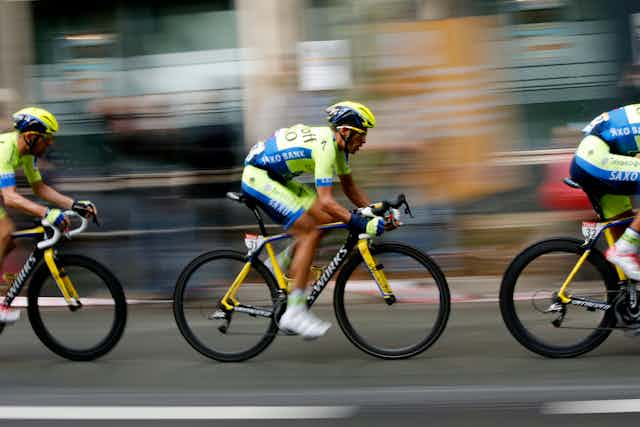
Unofficial rules of the Tour de France matter most
Associate Professor, Centre for Cultural Diversity & Wellbeing, Victoria University
Associate Professor of Sport Ethics, Victoria University
Disclosure statement
Craig Fry is funded by the NHMRC, ARC, and Victoria University. He leads the Culture and Values in Health research program at the Centre for Cultural Diversity and Wellbeing, Victoria University. Craig writes the Australian cycling history pages at Cycling Tips http://cyclingtips.com.au , and the Pushbikewriter column here at The Conversation. He is also a Research Associate of the Institute of Sport, Exercise and Active Living, Victoria University.
Dennis Hemphill was part of a team that had received funding under the Australian Government Anti-Doping Research Program.
Victoria University provides funding as a member of The Conversation AU.
View all partners
Riders in the Tour de France are engaging in a battle of wits as they follow two sets of rules – the official rules and the other set of “unofficial” rules that come with any competitive sporting challenge.
This other set of rules can occur in any sport and is described by Australian philosopher Fred D'Agostino as:
[an] unofficial system of conventions which determine how the official rules of the game will be applied in various concrete circumstances.
This means that while there are important rules in sport that define and regulate particular activities and competitions, they do not fully explain or determine how sport is actually played.
Basically, you don’t learn how to play sport by reading the official rule books. The full truth of how sporting competitions unfold is only revealed in the contest itself.
Seeing the unofficial rules in the Tour
The 2014 Tour de France is just a few stages old, and already we are seeing evidence of the official and unofficial rules of this great race – the Tour on paper versus the Tour on the road.
The first such moment came last Saturday when star sprinter Mark Cavendish crashed and badly injured himself metres from the finish of Stage 1 in Harrogate.
Footage of the incident shows Cavendish using his head to move Australia’s Simon Gerrans and secure a clear run to the finish line. Cavendish later apologised , admitting he caused the crash that brought him and Gerrans down.
The official UCI Discipline and Procedures rules specify penalties for irregular sprinting by riders. The Tour de France race regulations also say:
To ensure that sprints proceed according to regulations, riders who deviate from the line they have chosen will be subject to the penalties provided for in the table of penalties.
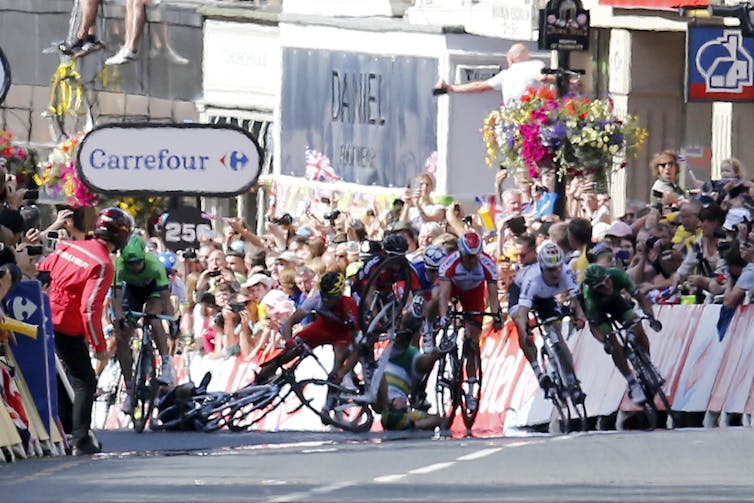
So, after viewing the crash video, it may come as a surprise to many that no official penalty for Cavendish’s seemingly reckless behaviour has been forthcoming.
As Gerrans’ post stage comments show, no rider enjoys being on the receiving end of a shunt that costs them a podium place (or worse). Gerrans was extremely diplomatic in his comments after the crash, when he had every right to be otherwise.
But, by the same token, rider protests and official complaints are rare in races such as the Tour.
Few penalties for crashes
And, while there are past examples of similar incidents in Tour de France sprint finishes that have resulted in official penalties ( Mark Renshaw in 2010, Robbie McEwen in 2005), the riders doing the pushing and shoving mostly escape sanctions.
Australia’s most successful Tour de France sprinter, Robbie McEwen, was famous for his physical approach to sprinting , and is still lauded as one of our toughest ever road riders.
The Cavendish/Gerrans crash highlights the fine line that exists between the official rules and the unofficial (yet no less influential) racing etiquette of professional cycling in big races such as the Tour de France.
Being pushed off a wheel or a line in the final run to a stage finish is a common and accepted part of professional cycling. Chances are we will see it again before this year’s Tour is done.
The unofficial rules
If you look closely enough, a host of other unofficial rules and race etiquette becomes apparent every year in the Tour de France.
Some entertaining and informative descriptions of these can be found in past opinion and commentary , sports journalism and in cycling blogs . There have even been books written on the topic.
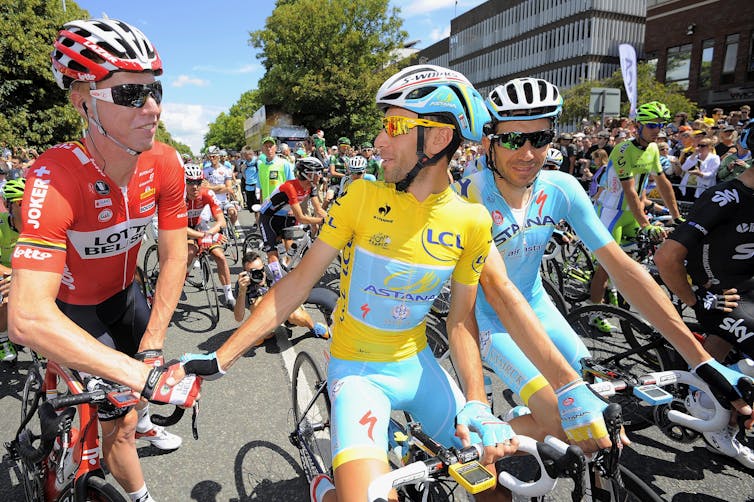
Some of these unofficial rules include:
- don’t attack the yellow jersey (race leader) on the last stage, even if you’re only seconds behind in the general classification
- don’t attack in the feed zone, or during a nature break
- don’t attack the yellow jersey or other contenders if they crash or experience a mechanical incident
- riders can draft behind the team cars or take a “sticky bottle” to get back to the main bunch (especially in the case of a mechanical incident or crash)
- race leaders and the experienced riders in the peloton (main pack of riders) can call a neutralisation or go-slow if race conditions are dangerous
If you doubt these things happen in the peloton, then you only need watch this year’s race. Or consider some of the more famous incidents in professional cycling over the years, for example:
- Criticism of Nairo Quintana after his attack during a neutralised stage of the 2014 Giro d’Italia
- The reaction to Alberto Contador attacking Andy Schleck after his chain slipped during Stage 15 of the 2010 Tour de France
- Jan Ullrich waiting after Lance Armstrong fell during Stage 15 of the 2003 Tour
- Second place GC riders not attacking the yellow jersey on the final stage despite being mere seconds behind (e.g. Cadel Evans 23 seconds to Alberto Contador in 2007, and 58 seconds to Carlos Sastre in 2008).
What is especially interesting is that many of the above unofficial rules are at odds with the written regulations that supposedly govern professional cycling.
Consider the following prohibited behaviours from the UCI discipline and procedures rules :
- irregular sprint in a stage race
- pushing off against car, motorcycle, rider
- cheating, attempted cheating, collusion between riders of different teams
- rider holding on to his team’s vehicle
- sheltering behind or falling into the slipstream of a vehicle
- follower leaning out or holding supplies out of vehicle
- acts of violence among riders, or towards anyone else
Again, you will see all of these in this year’s Tour de France.
Why do these unofficial rules exist?
It may seem strange that a sport like cycling with its long history of cheating of all types (including drug use and doping), also has a strong ethos of honourable racing within the professional peloton.

It has been argued that the ethos exists because of the extreme demands and dangers of professional cycling.
[…] merely to survive, the riders had to evolve a way of existing together, competing without putting each other in danger, and without making daily life impossible.
These unofficial rules of professional cycling are therefore an important part of the culture and functioning of this sport. To some extent these are also replicated at its lower levels, even down to the amateur club grades.
Some have even argued that the unofficial norms of cycling can complement the official rules and add to the attractiveness of the contest - especially where official monitoring and sanctioning costs imposed on riders for transgressions are low, or applied inconsistently.
Indeed, so entrenched are some of the unofficial rules that they may be seen by many riders as more legitimate than the official rules (and have a bigger influence on race progression and outcomes).
The strength of these unofficial rules is likely due to the following factors:
- they are made by, implicitly agreed, and explicitly practised by most riders
- these rules allow the riders to govern and control key moments in the race, especially around risks and dangers
- unofficial rules also provide a means by which a kind of natural justice or order of the peloton can be preserved from within
- such rules and race etiquette can build social cohesion in the peloton
So, in the Tour de France each year it is possible to see the influence of unofficial race rules and etiquette on the practice and outcomes of professional cycling.
The irony is the unwritten rules of the Tour may matter more to the riders than the official regulations.
The danger is the cultural processes responsible for producing these examples of in-race etiquette may be the same mechanism by which behaviours such as doping and other extreme forms of cheating develop and become normalised .
More Tour de France coverage on The Conversation .
- Tour de France

Faculty of Law - Academic Appointment Opportunities

Operations Manager

Senior Education Technologist


Audience Development Coordinator (fixed-term maternity cover)

Lecturer (Hindi-Urdu)
- Share full article
Advertisement
Supported by
Sports of The Times
At Tour de France, Rules of the Road Are Often Unspoken
No breakaways in tunnels and stop when the leader stops: guidelines keep the peace (but not always).

By Michael Powell
LIMOUX, France — On a muggy morning before another 115-mile race through the Pyrenees, the cyclist George Bennett peered at a few of us sweaty fourth-estate types, shrugged and said, “Looks like I have become a domestique.”
Bennett, a 29-year-old from New Zealand, is one of the best professional cyclists in the world, so to hear him talk of taking on the role of domestique — servant — in the late stages of the Tour de France is a bit like hearing the N.B.A.’s James Harden declare he has decided to close out the season as a defensive-minded role player.
The tousle-haired Bennett was expected to compete this year for the maillot jaune , the yellow jersey worn by the Tour’s leader. But in the course of this 2,200-mile race across France, he endured mishap piled atop miscalculation and fell out of contention. So he has accepted his fate and will spend the rest of the Tour, which has curled into the lung-burning high reaches of the Alps, lugging water and clearing space for his Jumbo-Visma teammates.
In the language of cycling, this alpha rider has become a domestique.
To ride in the slipstream of this grandest of cycling races for two weeks is to learn language, customs and rules no less powerful for being unspoken, to step inside a private club as I write as a bit the novice myself. (O.K., “a bit the novice” might understate matters in the eyes of hard-eyed riding sorts, who have complained that I referred in an earlier column — la scandale! — to the “cylinder” of the bicycle as opposed to the top bar. I will console myself this evening with an extra glass of a fine Alpine wine.)
Each of the Tour’s 22 teams has five or six domestiques, men whose job it is to sacrifice for the greater glory of their team’s lead cyclist. The term is an example of a curious upstairs-downstairs argot in what is at its core a working-class sport.
Domestiques provide wind-cover, going out in front of a team’s leading rider for long stretches and allowing him to conserve strength. The domestique also fetches water and food for teammates from the team cars that accompany the field, and even cannibalizes his own bike — or, in a worst-case situation, surrenders it — in service to the team’s alpha rider.
“The roles are pretty clear, and they have to be because otherwise everyone thinks they could win the tour and you lose your team structure,” Tony Martin, another fine cyclist with Jumbo-Visma told me. “And that becomes dangerous.”
Having disposed with roles, let’s move to the unspoken rules. Some are a vestige of a more genteel time, and a few have slid into history’s shadow. Once it was considered bad form to make a breakaway in a tunnel, though that is no longer forbidden. And if the peloton passed through the town or village of one of their own, the native son was given the brief honor of the lead.
Others remain ironclad. France’s Julian Alaphilippe is the 27-year-old sensation of this race, and with his explosive forays through the Alsace-Lorraine, the Massif Central and then down into the Pyrenean foothills he remains the cyclist with the best cumulative time. That lead comes accompanied by privileges.
When Alaphilippe decides he needs to take a nature break — the term of art for emptying his bladder — the peloton either stops and takes its own or slows enough to give him time to catch up. A television viewer can hazard a guess as to the timing of nature breaks as the NBC announcers cut away from the race and begin to rhapsodize about a particularly handsome château. Taking advantage of such a moment to attack is still considered bad form, and can result in a scolding on wheels. (Caveat: Should the need for a nature break arrive toward the frenetic end of a day’s racing, the biker just takes care of business as he pedals.)
To police these rules, spoken and not, it falls to the dominant riders to play hall monitor for the peloton. Earlier this week, two rivals got into it , jockeying for position as they raced from Pont du Gard, the Roman aqueduct in Provence, to the Alpine town of Gap. Temperatures had reached 105 degrees and the riders — both of whom carried reputations in the peloton as good guys — had grown tetchy. Alaphilippe pushed forward and advised them to knock it off.
“Maybe they were scared I was going to attack, so I just tried to calm them down,” he said. “I told them not to take any risks. I wasn’t going to attack.”
Race officials bounced the quarrelsome riders, including Jumbo-Visma’s Martin, from the Tour anyway, and levied big fines in what felt like a great overreaction given the brain boil temperature.
“We’ve gotten to the point in the race,” one coach told me in Nimes, “where everyone is exhausted and sick of everyone else. Even on the team bus, you have to be very, very careful what you joke about.”
There is, too, the question of injuries — the broken bones, torn tendons and broken teeth — and in cycling language the strange pejorative that accompanies it. The Tour is a cross between a marathon and a Formula One race. Most often, riders who fall crawl off the ground, spray antibiotic cream on road rashes and hop back on their bikes. But those who break bones or get concussed must withdraw.
Such injured cyclists are said — in Tour speak — to have “abandoned” the race, which carries a soupçon of disapproval.
This year’s Tour offered an exception: Last week, Rohan Dennis, one of the best time-trialers in the world, paused at a feed stop, put down his bike, and simply walked away . No mas, over and out, où est l’aéroport?
There were rumors Dennis was unhappy with his bike, with his team, perhaps even with the quality of his spandex. (Real rumor.) He’s not talking specifics and, at the least, we can safely say that he “abandoned” the race.
Others will soldier on, not least the alpha who ended up a domestique.
“I just have to deal with it and put effort into someone else’s race,” Bennett said of his final week in the Tour. “I worked as a domestique early in my career. So, I guess ….”
His voice trailed off.
“I can’t say I like it,” he added, “but that’s racing.”
Michael Powell is the Sports of The Times columnist. A native New Yorker, he joined The Times in 2007. He was part of teams that have won a Polk Award and a Pulitzer Prize. More about Michael Powell
Cycling Around the Globe
The cycling world can be intimidating. but with the right mind-set and gear you can make the most of human-powered transportation..
Are you new to urban biking? These tips will help you make sure you are ready to get on the saddle .
Whether you’re mountain biking down a forested path or hitting the local rail trail, you’ll need the right gear . Wirecutter has plenty of recommendations , from which bike to buy to the best bike locks .
Do you get nervous at the thought of cycling in the city? Here are some ways to get comfortable with traffic .
Learn how to store your bike properly and give it the maintenance it needs in the colder weather.
Not ready for mountain biking just yet? Try gravel biking instead . Here are five places in the United States to explore on two wheels.
2-FOR-1 GA TICKETS WITH OUTSIDE+
Don’t miss Thundercat, Fleet Foxes, and more at the Outside Festival.
GET TICKETS
BEST WEEK EVER
Try out unlimited access with 7 days of Outside+ for free.
Start Your Free Trial
Powered by Outside
Tour de France
The tour has been yellow fleeced by unwritten rules, there is no written rule that neutralizes in the entire tour de france when the yellow jersey has a problem. writing one would be crazy..
Heading out the door? Read this article on the new Outside+ app available now on iOS devices for members! >","name":"in-content-cta","type":"link"}}'>Download the app .
BERGERAC, France (VN) — There is no written rule that neutralizes in the entire Tour de France when the yellow jersey has a problem. Writing one would be crazy.
So is such an unwritten rule really sane?
[related title=”More Tour de France news” align=”right” tag=”Tour-de-France”]
When a mechanical sent Chris Froome’s arm into the air on the slopes of Mont du Chat on Sunday and Fabio Aru ducked underneath that gangly elbow, the debate rekindled . It’s one that hits the Tour every year: Wait or race? What’s proper, what’s right?
Perhaps, though it’s very ungentlemanly for me to say so, it’s time to ditch the gentlemanliness. Rip that page out of the “Unwritten Rulebook” and chuck it in the trash.
It’s a noble act, waiting for a rival in a moment of great need and maximal vulnerability. There is an argument that pro cycling’s inherent danger forces this sort of chivalry, that cycling is gallant by necessity. Respect for competitors is a built-in safety measure. What better way to show respect than to wait in a crucial moment? It proves that a rider cares more about his competitors than any mere bicycle race. Bad luck happens to everyone; treat others as you wish to be treated; what goes around comes around; etc.
It wasn’t always this way though. As a tongue-in-cheek illustration, allow me to present a brilliant little tweet from a British colleague, Lionel Birnie:
[twitter url=”https://twitter.com/lionelbirnie/status/884118618820280320″]
Perhaps you know this story? If not, here are the “Spark Notes:” While riding in the overall lead of the Tour de France down the Tourmalet in 1913 (he was not in the yellow jersey, which hadn’t been invented yet, though Eugene Christophe would be the first to wear it in 1919), Christophe’s fork cracked and failed. He walked with his bike over 10 kilometers down the mountain to the next town, where he found a blacksmith. The rules at the time forbade outside assistance. He fixed the fork himself, hammering away on an anvil under the watchful eye of Henri Desgrange. He lost nearly four hours.
Nobody waited for the leader of the Tour. In fact, legend suggests that a few of his competitors taunted him as they rode past. It was understood, then, as it is not quite understood now, that staying upright on a functional bicycle is as much a part of a bike race as the pedaling itself.
These days, the peloton almost always waits. The Unwritten Rules are clear. When Froome’s hand went up Sunday, and Aru attacked, Nairo Quintana followed. So did Dan Martin and Richie Porte. But then the latter two began motioning for a ceasefire. They neutralized the front group until Froome returned, deescalating the world’s biggest bike race in one of the few moments across three weeks that was ripe for real escalation. The decision to wait likely affected the day’s result, and maybe the overall result, in ways we’ll never know.
The unwritten rule that compels rivals to wait for the yellow jersey even when the race is on — during important climbs or anywhere near the finish — is relatively new. Though there are select instances of such slowdowns occurring prior, the tradition was in stone, so to speak, during the Lance Armstrong era. Armstrong waited for Jan Ullrich in 2001 after the German tumbled off the side of the road. Ullrich then waited for Armstrong in 2003 following the American’s musette-bag crash. Within a few years, charging on as a rival floundered was seen as a treasonous.
The problem with the Unwritten Rulebook is that it is reliant on the elastic subjectivity of circumstance. While the Tour waited for Froome and his flat, it did not wait for Rigoberto Uran and his singlespeed . It did not wait for Dan Martin and his crash . It didn’t wait to see if Richie Porte could continue . This unwritten rule is not an indication of a rider’s respect for his competitors because it’s not applied to all of them, or even some of them. Not consistently, anyway.
One can hem and haw on the specifics. (Never wait when the race is on? When did he attack? Was it before or after the “on” button was hit? Where is the “on” button, and what does that button even look like?). That is precisely the point. Few can agree. Riders make these decisions on their limit, in the heat of the moment, without a full understanding of the events unfolding around them.
Riders can use the Unwritten Rulebook for semi-nefarious purposes too. Abuse of power, even. I present an incident from last year’s Tour de France . Sky’s Ian Stannard crashed in the leadup to Mont Ventoux, falling behind Simon Gerrans. Chris Froome pulled up a few moments later for a supposed nature break. And so with 30km to go, charging for Mont Ventoux, the crux of the entire Tour, Sky forced the peloton to make a decision: ride on and leave yellow behind, or wait under a questionable application of the “Don’t Attack A Yellow Jersey On Nature Break” rule.
Alejandro Valverde was livid, and he should have been.
They say this unwritten rule ensures that cycling is a test of athletes, not machines. But cycling is a test of athletes and machines. Always has been, just ask poor Christophe. If it was not it would be running.
They say this unwritten rule ensures that luck does not pick the Tour’s winner. But luck is sport and sport is luck and aren’t you supposed to make your own, anyway?
This is easy for us to say, us punters on the couch and in the pressroom. Some of these unwritten rules exist as a method of self-preservation. But not this one. This one can’t be written down because seeing it in writing would reveal how truly silly it is. Leaving it unwritten makes it no less absurd.
Popular on Velo
>", "path": "https://velo.outsideonline.com/road/road-racing/patrick-lefevere-issues-public-apology-over-statements-it-was-never-my-intention-to-harm-anyone/", "listing_type": "recirc", "location": "list", "title": "patrick lefevere issues public apology over controversial comments: ‘it was never my intention to harm anyone’"}}'> patrick lefevere issues public apology over controversial comments: ‘it was never my intention to harm anyone’, >", "path": "https://velo.outsideonline.com/gravel/gravel-racing/gravel-pros-levis-gran-fondo-road-race/", "listing_type": "recirc", "location": "list", "title": "why are so many gravel pros doing levi leipheimer’s new road race"}}'> why are so many gravel pros doing levi leipheimer’s new road race, >", "path": "https://velo.outsideonline.com/road/road-gear/review-trek-rsl-knit-shoes/", "listing_type": "recirc", "location": "list", "title": "review: trek rsl knit shoes – incredibly comfortable, hard to keep clean"}}'> review: trek rsl knit shoes – incredibly comfortable, hard to keep clean, >", "path": "https://velo.outsideonline.com/road/road-racing/wout-van-aert-forced-to-skip-the-giro-ditalia-its-a-big-shame/", "listing_type": "recirc", "location": "list", "title": "wout is out, no giro d’italia for van aert: ‘it’s a big shame’"}}'> wout is out, no giro d’italia for van aert: ‘it’s a big shame’.
- International edition
- Australia edition
- Europe edition
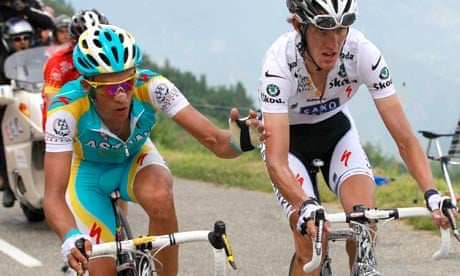
Winning the Tour de France means learning its unwritten rules
On the face of it, it might seem curious, even perverse, that a sport where the lowest form of cheating has been endemic over the years makes a big deal out of ethical codes. Since the sport began in the 19th century, drug-taking has always been there, and in the last 12 years it's been revealed to be systematic at the highest level. It's cheating, full stop. It's the ultimate way to gain an unfair advantage. No ethics there.
And yet there is massive outrage and heated debate when a competitor takes advantage of a big rival having a mechanical problem, as happened on Monday when Alberto Contador, favourite to win the Tour, pressed on after Andy Schleck, the biggest threat to him, unshipped his chain at a key moment. Contador is held to have broken an unwritten law : you don't attack your rival when he has crashed or had a mechanical.
Written ethical codes don't count for much in cycling. There have been a couple of attempts to make professional cyclists sign charters stating they won't take drugs, but they have been quietly abandoned, because they didn't stem the tide of positive tests, and they were viewed solely as window-dressing. The unwritten rules are another matter. They are everywhere, although the Contador-Schleck episode shows that as in Pirates of the Caribbean, the "code" is sometimes merely viewed as a guideline.
Every day, at a certain point during a stage of the Tour, many of the riders decide to stop to answer nature's call at the side of the road. No one will attack when its time for pause pipi . To do so would be unethical. So too an attack at a feeding station, when the field have slowed down to snatch bags of food from helpers at the roadside. Earlier this season, Team Sky raised hackles by attacking at a feed and later revenge was taken: when a Sky rider stopped for a leak, up went the pace.
The yellow jersey is key, because of the status it holds. As well as the rule about waiting for the wearer of the jersey, he gets more road space within the peloton – if he wants to cut through to the front the others let him pass. And here's another one: if two riders contest the stage win ahead of the bunch, and one of them is going to pull on yellow, he lets the other man take the stage, on the grounds that both of them are guaranteed something. Sometimes, if the pace is slow, a local rider may be allowed to ride ahead to greet his family at the roadside: what he mustn't do, is use that "leave of absence" to try to win the stage.
That is just one of a complex network of bartering, informal alliances, and mutual help that goes on across the peloton. Teams with the same interest will share the work chasing a break, agreeing to use a certain number of riders each. They will buy in assistance with (sometimes) cash or (usually) favours if their riders are not strong enough, and woe betide the team that doesn't pay up.
To understand why this system exists, you need to look at the nature of cycling. The calendar is massive, involving hundreds of days of racing during the year. The races have up to 200 cyclists sharing the same road space , facing the same dangers. Not surprisingly, merely to survive, the riders had to evolve a way of existing together, competing without putting each other in danger, and without making daily life impossible.
So why did the unwritten code not extend to drug-taking? Probably because, until very recently, taking drugs was seen as just another way of combating the demands of the sport. It's only recently begun to be seen as unethical and a danger in itself: it will take a while for that to be universally accepted.
- Green living blog
- Tour de France
Comments (…)
Most viewed.
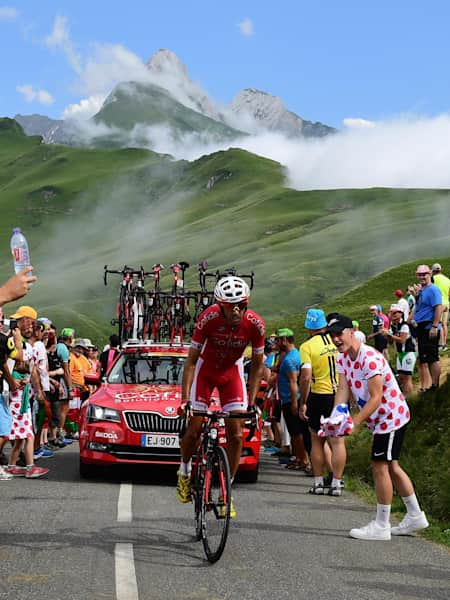
A beginner’s guide to the Tour de France
A little bit of history.
A snapshot of Tour de France history
© Nationaal Archief
2019 Tour de France race route
Endurance cycling tips: a beginner’s guide, what the coloured jerseys mean.
Geraint Thomas during Tour de France 2018
© Pauline Ballett
One of the most intense start lines in sports
7 things endurance cyclists should do to stay comfortable
Tour de france teams, tour de france etiquette.
Riders must know TDF etiquette
© Alex Broadway
Interval training sessions for cyclists
Following the race.
Team Sky during Tour de France 2018
Names to watch out for
Yellow jersey, green jersey, wout van aert explains how to breakaway from the bunch like a pro, a tour de france dictionary.
The crowds cheering on the peloton
10 mental hacks for surviving a road cycling race
- Subscribe to newsletter
It's going to be so great to have you with us! We just need your email address to keep in touch.
By submitting the form, I hereby give my consent to the processing of my personal data for the purpose of sending information about products, services and market research of ŠKODA AUTO as well as information about events, competitions, news and sending me festive greetings, including on the basis of how I use products and services. For customer data enrichment purpose ŠKODA AUTO may also share my personal data with third parties, such as Volkswagen Financial Services AG, your preferred dealer and also the importer responsible for your market. The list of third parties can be found here . You can withdraw your consent at any time. Unsubscribe
Tour de France – The Rules Explained

Some teams will focus on the general classification Yellow Jersey, whereas others will focus on winning sprints for The Green or the King of the Mountains Spotted Jersey. There are many rules, both spoken and unspoken, as teams stand to gain a lot from cooperation and respect. Here is what you need to know to enjoy watching Le Tour.
Keep the leaders safe
The start of Le Tour is always an edgy affair as teams compete to establish themselves at the head of the peloton. Crashes and injuries are a real risk, so team leaders need to be protected by their domestiques who effectively muscle everyone else away.

The irony is, the more the teams muscle each other away, the greater the risk of crashes in the peloton. The safest place to be is the front, and everyone is fighting to be there. This Catch 22 situation is almost impossible to mitigate through any official rules, but it’s exciting to watch.
The Yellow Jersey
Winning the General Classification (GC) means you get to wear The Maillot Jaune, aka The Yellow Jersey. To win the GC the leader of a race team must complete all the stages with the lowest overall time.
This means that a GC contender should be a solid all-rounder, equally at home on the mountains as they are in time-trial stages. It can become confusing when you consider a rider could win the GC without winning any individual stage.

Nutrition for Women – How to Get Enough Vitamins and Minerals
Think of it like this – Mark Cavendish may win every flat stage suited to a sprinter, but will probably finish mountain stages at least 20 minutes behind the likes of Nairo Quintana, whereas Quintana will finish a sprint stage within 3 minutes of Cavendish.
Breaks and stage wins
Regardless of who wins the overall Yellow Jersey, an individual stage win on Le Tour is always a special event, and smaller teams will often target one or two specific stages out of the Tour simply to get on the podium. Breaks are the coolest way to achieve that, but not the easiest.
Early on in a stage you may see a small group of riders attempt a break. Usually these are lower order riders with nothing to lose – they keep their sponsors happy by grabbing TV coverage, and most of the time they’re easily caught by the peloton that uses energy much more efficiently.
Royal Breaks
That doesn’t mean that Yellow and Green Jersey contenders can’t have some fun going for a break, but they’re only likely to do it when conditions go in their favour – and in 2016 that’s exactly what Froome and Sagan exploited.
Stage 11 of Le Tour was plagued with crosswinds, so the peloton had been doing their best to speed through it. Sagan found himself at the front with Thomas, Bodnar, and Froome. The Peloton was battered and bruised from minor crashes down the coastal route from Carcasonne, so when Sagan attacked, few cyclists felt confident enough to respond.

Froome leapt on Sagan’s wheel, and Bodnar and Thomas read the situation and realised a fully-fledged Royal Break was on the cards, with both the Yellow and Green Jerseys of Froome and Sagan committed to escaping the peloton. Sagan won the stage, and Froome put a significant dent into his rivals for the Yellow Jersey, finishing the stage in 2nd place.
King of the Mountains
Points are given at the top of climbs for suitably impressive performance, so specialist climbers have an advantage. Climbs are categorised from 1 to 4, with 1 being the steepest. The numbers loosely correspond to the gears of a car – so to drive up a Cat 1 climb you’d need to stick your car in first gear.
Race planners may give big points at the top of a Cat 3 climb if it’s deemed long enough to pose the same challenge as a shorter Cat 1 climb. I should add that there is one climb more difficult than a Cat 1 climb – the Hors Catégorie (HC). An HC climb is beyond categorisation and originally described a climb so severe a car couldn’t pass.
Getting points for the Green Jersey
Points can be given for winning sprints at various parts of a stage, often early on to encourage teams to either up the tempo in the peloton or break early in the hopes the break may succeed.
More points are given to the sprint at the end of the stage, and this encourages teams with specialist sprinters like Sagan, Greipel, Kittel, or Cavendish to stay together. This leads to a similar paradox of teams trying to dominate the front of the peloton to give their team leader a clear run at the finish line.

The classic race rule applies – the rider with the racing line may stick to it knowing that any competing cyclist will yield their line when they realise they have the disadvantage. Naturally, this doesn’t always work in the heat of the moment and spectacular crashes are a real risk in bunch sprints.

Articles you might like

Dominant van der Poel Wins Paris-Roubaix with Brilliant 60km Solo
The safest bet in the history of gambling, as sure as putting money on the sun rising tomorrow, was that Mathieu van der Poel (Alpecin-Deceuninck) would win Sunday’s Paris-Roubaix. It was a sure thing not only because he is a once-in-a-generation talent, perhaps the best…

Ayuso Wins Itzulia Basque Country, Vingegaard Tour Prospects in Doubt
The 21-year-old Spaniard Juan Ayuso, with stellar support from his UAE Team Emirates, won the crash-marred Itzulia Basque Country, overturning a deficit of 4 seconds to race leader Mattias Skjelmose (Lidl-Trek) on the final climb of the race.

Lotte Kopecky Claims Victory at Paris-Roubaix: ‘It was exactly as we planned’
After an intense competition on the challenging pavé of northern France, the world champion, Lotte Kopecky, emerged victorious at the Paris-Roubaix Femmes, outpacing rivals Elisa Balsamo and Pfeiffer Georgi in a thrilling sprint finish within the iconic Roubaix velodrome.

Safety-Inspired Route Change to Paris-Roubaix Provokes Complaints
A minor route change to this Sunday’s Paris-Roubaix undertaken by race organizers ASO at the request of the professional riders’ union, the CPA, to reduce the danger of a crash at the entrance to the notorious Trouée d’Arenberg, or Forest of Arenberg, has unleashed a…
- Mataram, NTB
- +62-859-3702-0959
- [email protected]
Unwritten Rules of Tour de France: Legal Insights & Analysis
The intriguing unwritten rules of the tour de france.
As a fan of the iconic Tour de France, there are countless reasons to be captivated by the grueling race. From the stunning landscapes and intense competition to the unfathomable physical endurance of the athletes, the Tour de France is a spectacle like no other. However, there is another aspect of the race that deserves attention – the unwritten rules that govern the conduct of the riders and teams.
While the Tour de France has official regulations, there are also unwritten rules that have been passed down through generations of cyclists. These unwritten rules govern the behavior and ethics of the riders, adding an extra layer of complexity to the race.
One of the most well-known unwritten rules is the concept of fair play and sportsmanship. In the heat of competition, riders are expected to show respect for their fellow competitors and not take advantage of misfortune or mistakes. This unwritten rule has been demonstrated time and time again, with riders waiting for their rivals after crashes or mechanical failures.
Case Studies
One of the most famous examples of adherence to unwritten rules in the Tour de France occurred in 2010 when Alberto Contador mistakenly attacked Andy Schleck after Schleck`s chain slipped. Contador`s move was criticized, and it a debate about the of sportsmanship in cycling.
In another case, in a show of and respect, the main stopped for 10 to the use of drugs in the 1964 Tour de France. This extraordinary display of unity highlighted the unwritten rule of protecting the integrity of the sport.
According to a study conducted by Cycling Weekly, 85% of professional cyclists believe that unwritten rules are an essential aspect of the Tour de France. Additionally, of stated that have witnessed a of adherence to unwritten rules the race.
The Intriguing Unwritten Rules of the Tour de France add a of and respect to an event. They embody the spirit of fair play and camaraderie, elevating the race beyond a mere competition. As fans, it`s important to recognize and appreciate the unwritten rules that contribute to the unique character of the Tour de France.
Introduction
This represents the between the of the Tour de France and the unwritten rules that the conduct and of all involved in the event.
Tour de France Unwritten Rules: Legal FAQs
Tour de France: Will Contador pay for his breach of cycling's unwritten rules?
Tour de France Stage 15: Alberto Contador won the yellow but some say he committed a breach of race etiquette by attacking in the last climb of Stage 15 just as race leader Andy Schleck's chain popped off.
- By Jon Brand Correspondent
July 20, 2010 | Pau, France
Defending Tour de France champion Alberto Contador stirred controversy Monday when he attacked the final climb of Stage 15 just as race leader Andy Schleck 's chain popped off.
But why? As Lance Armstrong 's team director Johan Bruyneel put it, it was just a smart move.
“You can’t say to Contador, ‘Hey, wait for Andy,’” he told reporters. “There’s no gifts in this race.”
IN PICTURES: Scenes from the 2010 Tour de France
But to others in the tight-knit professional cycling community, Contador – whose attack moved him into the overall race lead – committed a grave breach of the sport's unwritten rules of etiquette.
“Contador just gained a great chance to win, but he lost the chance to win greatly,” tweeted Cervélo TestTeam owner Gerard Vroomen.
The rules, from sunglasses style to tactical savvy
Here’s a primer of cycling's rules of the road for newcomers.
Style counts: Sunglasses go outside the helmet straps; wearing yellow is usually reserved for the Tour de France; and if you win a stage, zip up your jersey to give your sponsor’s logo some TV time.
Tactical savvy is also essential knowledge: Follow the wheel in front of you to avoid crashes; pull your weight on breakaways.
And if a rival is beset by misfortune, like a mechanical problem or a crash, wait for him to get back on the bike. When the race leader has to use the bathroom, everyone slows down.
But, these being unwritten, there’s always room for interpretation.
One good turn deserves another
Whereas Bruyneel supported Contador's move yesterday, his team took a different tack some years back.
In 2001, he was managing the US Postal team when Armstrong waited for his rival Jan Ullrich to recover after a crash.
Two years later, on Stage 15 of the Tour, Ullrich returned the favor when Armstrong’s handlebars got caught up in a fan’s bag on a key climb.
“If I would have won this race by taking advantage of someone's bad luck, then the race was not worth winning,” Ullrich said after the stage.
Conversely, there is such a thing as payback in the pro peloton . Much like retaliation pitches in baseball, riders or teams will wait for the right moment to exact revenge on rivals who have wronged them.
“It’s usually a dish that’s best served cold, many races later, but sometimes it happens in the same race,” says Cycling Weekly’s Gregor Brown.
During a stage of February’s Tour of Qatar , Britain ’s Team Sky, aggrieved at the lack of cooperation from other teams to catch a breakaway, launched an attack while many riders were picking up food – a serious faux pas among cyclists.
Later that day, Sky’s Edvald Boasson Hagen , the race leader, had to make a pit stop.
As punishment for his team’s earlier transgression, rivals charged ahead without him, eventually knocking Boasson Hagen out of the lead.
Will Contador be punished by other cyclists?
Whether Contador will be subject to similar treatment remains to be seen as the Tour makes its way toward Sunday’s final stage in Paris.
Though Schleck declared that he would get “revenge” for yesterday’s incident and has former teammates that may look out for him – cooperation among teams is another unspoken tradition – Contador has much support in the peloton as well, especially from fellow Spanish riders.
In fact, the absence of a rules enforcer in the peloton may be the most interesting detail to come out of the ordeal.
There has been a clear hierarchy in the past, with so-called bosses like Lance Armstrong advising the peloton and doling out punishments.
But struggling through his last Tour , Armstrong may be more concerned with finishing the race than policing it.
And the unwritten rules may be suffering.
“It’s kind of like anarchy right now so we’re seeing these things happen,” says Cycling Weekly’s Brown.
Tour de France 101: How long is the race?
Tour de france 101: is this a race of individuals or teams, how the tour de france's yellow jersey came to be yellow, related stories, tour de france stage 15: schleck vows 'revenge' after contador steals lead, share this article.
Link copied.
Subscription expired
Your subscription to The Christian Science Monitor has expired. You can renew your subscription or continue to use the site without a subscription.
Return to the free version of the site
If you have questions about your account, please contact customer service or call us at 1-617-450-2300 .
This message will appear once per week unless you renew or log out.
Session expired
Your session to The Christian Science Monitor has expired. We logged you out.
No subscription
You don’t have a Christian Science Monitor subscription yet.

Masters 2024: How Bryson DeChambeau broke an unwritten rule of Augusta National
T he problem with unwritten rules is, well, they’re unwritten. What is obvious for some needs to be spelled out for others, and without fine print things tend to go sideways. All of which is to say, you can’t blame Bryson DeChambeau on this one.
DeChambeau has long had a penchant for inadvertently rubbing the golf cognoscenti the wrong way. Part of this stems from standing out in a sport that genuflects to conventionality. Other times, it’s for matters like comparing himself to George Washington and Albert Einstein before earning a tour card or calling Augusta National a “par 67” after capturing the U.S. Open at Winged Foot. But before Bryson became Bryson, he may have accidentally broken an informal code at Augusta National.
The crime? Playing too much.
RELATED: These golfers nearly won a green jacket, and the heartache is real
When a player qualifies for the Masters, they are invited to visit Augusta National in the months leading up to the tournament for practice rounds. For years, there was no stated limit for how many visits one could make to the venerable property, but given the busy schedules of professional players, many could only find time for one-to-two visits, max, leading up to the Masters. But amateurs have a bit more latitude in their schedules, and DeChambeau, as the 2015 U.S. Amateur champion, took full advantage of the opportunity.
How many times DeChambeau actually played prior to the 2016 Masters is somewhat of a legend, with some corners of the golf industry asserting DeChambeau made over two dozen trips. The actual number is likely much lower—the Augusta Chronicle reported DeChambeau made 12 trips in the eight months before the Masters, not counting tournament week practice rounds—while DeChambeau himself said he played the course “10 times” prior to the tournament.
Bryson DeChambeau on the fifth hole during the second round of the 2016 Masters.
Scott Halleran
“Been very, very fortunate to do that and gained a lot of experience,” DeChambeau said that week. “I would say in preparation, I couldn't tell you an exact number, but those 10 rounds definitely did help, and this week we've got a lot of great information, as well. Accumulated hours, let's see, probably 50 hours, including all the practice rounds and the days that I've played.”
The practice clearly helped; at one point in the second round DeChambeau was just one off the lead as an amateur before suffering a triple-bogey at the 18th hole. Still, he made the cut and earned low amateur honors at the tournament and turned professional the very next week.
RELATED: Eclipse will give players, patrons a unique experience at Augusta National
Fast forward a few years later, when U.S. Mid-Amateur champ Matt Parziale was on the Drop Zone podcast, and revealed that after he earned his Masters invite, he received a packet from Augusta National with information about the tournament. And in the packet was a notification that Parziale would get a maximum of five visits prior to the Masters.
“It used to be unlimited,” Parziale said, “but someone abused it.”
In DeChambeau’s defense, which of us wouldn’t try to play Augusta National as much as possible given the chance? Moreover, there’s long been a rumor that too much play is often a no-no for members themselves. Still, for a man who sees himself as a paradigm breaker, forcing an unwritten rule to be written is par for the course for Bryson DeChambeau.
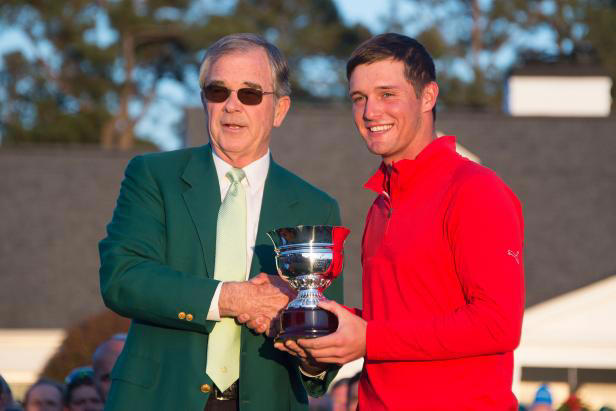
- Live & Schedule
- Australian Open
- Football Home
- Fixtures - Results
- Premier League
- Champions League
- Europa League
- All Competitions
- All leagues
- Snooker Home
- World Championship
- UK Championship
- Major events
- Tennis Home
- Calendar - Results
- Roland-Garros
- Mountain Bike Home
- UCI Track CL Home
- Men's standings
- Women's standings
- Cycling Home
- Race calendar
- Tour de France
- Vuelta a España
- Giro d'Italia
- Dare to Dream
- Alpine Skiing Home
- Athletics Home
- Diamond League
- World Championships
- World Athletics Indoor Championships
- Biathlon Home
- Cross-Country Skiing Home
- Cycling - Track
- Equestrian Home
- Figure Skating Home
- Formula E Home
- Calendar - results
- DP World Tour
- MotoGP Home
- Motorsports Home
- Speedway GP
- Clips and Highlights
- Olympics Home
- Olympic Channel
- Rugby World Cup predictor
- Premiership
- Champions Cup
- Challenge Cup
- All Leagues
- Ski Jumping Home
- Speedway GP Home
- Superbikes Home
- The Ocean Race Home
- Triathlon Home
- Hours of Le Mans
- Winter Sports Home
Bradley Wiggins explains the unwritten rules of toilet breaks at the Tour de France
Bradley Wiggins discusses the internal politics and a unwritten rules behind stopping for a toilet break at the Tour de France. During Tuesday’s Stage 16, once a breakaway had formed, many of the leading riders including overall leader Primoz Roglic stopped at the side of the road for some natural relief. This explains how that is managed without damaging those riders’ race position.

IMAGES
COMMENTS
20 years ago this July, on the final climb of the final mountain stage of the 2003 Tour de France, Jan Ullrich finally looked capable of defeating his old adversary, Lance Armstrong. For arguably the only time during his seven-year-reign, the disgraced Texan appeared out-of-sorts at the Tour.
In this video, we will list a few of the weirder facts you may not know about The Tour de France. We've also enlisted the help of GCN+'s own Cillian Kelly to dive into some of the lesser-known historical facts of this crazy race. 0:00 - Intro. 1:12 - Podium dress code. 1:36 - Keeping cool. 2:11 - Unwritten rules. 3:19 - Historical facts.
The Tour de France, the most fantastic race on earth. For the month of July, cycling fans are glued to the action. In this video, we will list a few of the w...
Timekeeper-commissaires shall give a new time. However, in stages expected to finish in bunch sprints, the time gap required for a split shall be 3 seconds - Article 14. The world's biggest bike ...
Here is a guide to the unwritten rules of the Tour de France's most harrowing moments. By Chris Fontecchio Updated Jul 15, 2018, 9:25am EDT Share this story. Share this on Facebook ...
Unofficial rules of the Tour de France matter most Published: July 9, 2014 4:16pm EDT. ... The irony is the unwritten rules of the Tour may matter more to the riders than the official regulations.
The unwritten rules of the Tour de France once included a ban on launching attacks in tunnels. Christophe Ena/Associated Press. To police these rules, spoken and not, it falls to the dominant ...
The Tour de France, the most fantastic race on earth. For the month of July, cycling fans are glued to the action. In this video, we will list a few of the weirder facts you may not know about The Tour de France. ... 2:11 - Unwritten rules 3:19 - Historical facts 7:23 - Team cars 8:18 - The party stage 9:07 - Time cut 10:07 - Time ...
If not, here are the "Spark Notes:" While riding in the overall lead of the Tour de France down the Tourmalet in 1913 (he was not in the yellow jersey, which hadn't been invented yet, though Eugene Christophe would be the first to wear it in 1919), Christophe's fork cracked and failed. ... The Unwritten Rules are clear. When Froome's ...
William Fotheringham: Scheduled loo breaks, family visits and not attacking when your opponent's chain comes off - all some of the Tour de France's unwritten rules
The Tour de France, the most fantastic race on earth. For the month of July, cycling fans are glued to the action. In this video, we will list a few of the weirder facts you may not know about The Tour de France. We've also enlisted the help of GCN+'s own Cillian Kelly to dive into some of the lesser-known historical facts of this crazy race.
The Tour de France is full of quirky protocols, both written and unwritten. Here are our 10 favourites.Click here to subscribe to GCN: http://gcn.eu/Subscrib...
Team of the Yellow Jersey has to supply all other team cars with champagne on the final day. General one for cycling if your opponent suffers a mechanical issue or a flat you do not take advantage and stop racing until the other rider gets back into the peloton. This happened when Bradly Wiggans won his first TdF.
2019 Tour de France race route. Starting in Brussels on July 6, it winds its way 3,480km around the country in 21 stages, which breaks down into 7 flat stages, 5 hilly stages, 7 mountain stages, 1 ...
Stream the Tour de France Femmes live and on-demand on discovery+. You can also watch all the action live on eurosport.co.uk. ... One of the unwritten rules of cycling is to not attack the yellow ...
The Movistar rider suffered an untimely mechanical on Stage 8 of the Tour de France Femmes that saw her change bikes three times. She also suffered a puncture. She also suffered a puncture. Each ...
Tour de France - The Rules Explained. By WeLoveCycling June 30, 2017 at 1:13 pm. Some teams will focus on the general classification Yellow Jersey, whereas others will focus on winning sprints for The Green or the King of the Mountains Spotted Jersey. There are many rules, both spoken and unspoken, as teams stand to gain a lot from ...
The Tour de France is so magical. One if not my fav sporting events. Goes on for three weeks. It's on all day so you can come and go as you please. You see so much countryside and learn so much history. Cycling really is beautiful. Edit : had to change it from 2 to 3 weeks! Love it ! Edit 2: also, the fans !!!!!
The Intriguing Unwritten Rules of the Tour de France As a fan of the iconic Tour de France, there are countless reasons to be captivated by the grueling race. From the stunning landscapes and intense competition to the unfathomable physical endurance of the athletes, the Tour de France is a spectacle like no other.
Tour de France Stage 15: Alberto Contador won the yellow but some say he committed a breach of race etiquette by attacking in the last climb of Stage 15 just as race leader Andy Schleck's chain ...
Tadej Pogacar, despite being a two-time winner of the Tour de France, does not fully use the power the yellow jersey affords, according to Bradley Wiggins.
The problem with unwritten rules is, well, they're unwritten. What is obvious for some needs to be spelled out for others, and without fine print things tend to go sideways. All of which is to ...
Bradley Wiggins discusses the internal politics and a unwritten rules behind stopping for a toilet break at the Tour de France. During Tuesday's Stage 16, once a breakaway had formed, many of ...